Ghana braids have become one of the most sought-after protective hairstyles for Black women worldwide. We’ve watched this stunning traditional African braiding technique transform from a cultural heritage practice into a global beauty phenomenon that’s gracing red carpets and social media feeds everywhere.
These intricate braids aren’t just about looking fabulous – they’re a perfect blend of style and hair protection. We love how Ghana braids offer versatility while keeping natural hair healthy and growing. Whether you’re looking for a low-maintenance style for busy weeks or want to make a bold fashion statement, these braids deliver on both fronts.
What makes Ghana braids truly special is their ability to suit virtually any face shape and lifestyle. From sleek straight-back patterns to creative curved designs, we’ll show you everything you need to know about this timeless protective style that’s captured hearts across continents.
What Are Ghana Braids and Why Are They So Popular?
Ghana braids represent a stunning fusion of traditional African artistry and contemporary hair fashion. These intricate protective styles have captured hearts worldwide for their beautiful aesthetic and practical benefits.
Origins and Cultural Significance
Ghana braids trace their roots back centuries to West African communities, particularly in Ghana where the technique earned its name. Traditional braiders developed this cornrow variation as both an art form and practical hair management solution for women across the region.
Cultural significance runs deep within every strand of these braids. African communities used braiding patterns to communicate social status, age, marital status, and tribal affiliation through exact designs and techniques passed down through generations.
Ancestral knowledge transferred from mothers to daughters created a rich braiding heritage that survived the Atlantic slave trade. Enslaved Africans brought these techniques to the Americas, where they evolved while maintaining their cultural essence and protective qualities.
Modern Ghana braids honor this legacy while adapting to contemporary lifestyles. We see celebrities like Lupita Nyong’o and Yara Shahidi proudly wearing variations that celebrate their African heritage on global platforms.
Modern Appeal and Versatility
Versatility makes Ghana braids incredibly appealing to today’s busy women. These styles can last 6 to 8 weeks with proper care, making them perfect for professionals, students, and active individuals who need low maintenance hair answers.
Protective benefits attract women seeking healthy hair growth options. Ghana braids shield natural hair from environmental damage, heat styling, and daily manipulation while promoting length retention and scalp health.
Styling flexibility allows endless creative possibilities from sleek straight back cornrows to intricate geometric patterns. Popular variations include:
- Straight back Ghana braids for professional settings
- Side swept designs for romantic occasions
- Zigzag patterns for bold, artistic looks
- Feed in techniques for gradual thickness transitions
Fashion forward appeal has elevated Ghana braids from traditional protective style to runway ready statement. Social media platforms showcase thousands of creative interpretations, inspiring women globally to experiment with colors, lengths, and decorative accessories.
Economic accessibility makes Ghana braids attractive compared to other protective styles. Most installations cost between $100 to $300 depending on complexity and location, offering excellent value for styles lasting multiple weeks.
Essential Preparation Steps Before Getting Ghana Braids
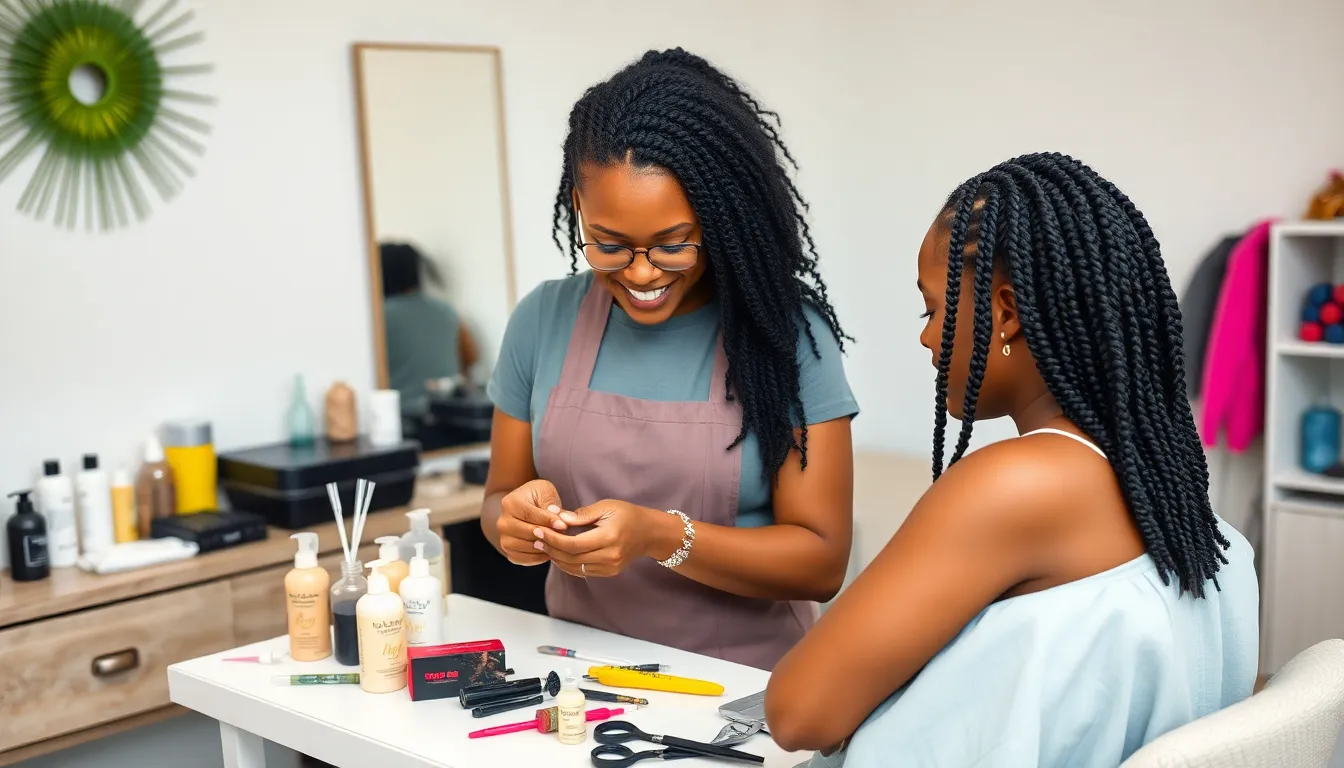
Proper preparation sets the foundation for stunning Ghana braids that last weeks and keep your natural hair healthy. We’ve identified three crucial steps that ensure optimal results for your protective styling journey.
Hair Health Assessment and Conditioning
Assess your scalp and hair condition before scheduling your Ghana braids appointment. We recommend examining your scalp for any irritation, cuts, or sensitive areas that might worsen during the braiding process. Check your hairline and edges for thinning or breakage, as Ghana braids require some tension that could affect already weakened areas.
Clarify your hair with a deep cleansing shampoo to remove product buildup and create a clean foundation. We suggest using sulfate-free clarifying shampoos that won’t strip your hair’s natural oils while thoroughly cleaning your scalp and strands.
Deep condition your hair 2-3 days before your appointment to maximize moisture retention. Apply a protein-free deep conditioner from mid-shaft to ends, leaving it on for 15-20 minutes under a plastic cap. This preparation step strengthens your hair cuticles and reduces the likelihood of breakage during the braiding process.
Trim any split ends to prevent further damage while your hair is braided. We recommend visiting a professional stylist for a light trim, focusing on removing damaged ends that could travel up the hair shaft during the 6-8 week protective styling period.
Gathering the Right Tools and Materials
Select high-quality braiding hair that matches your desired thickness and texture preferences. We recommend choosing between synthetic options like Kanekalon or X-Pression hair, or human hair extensions for the most natural look and feel. Purchase 6-8 packs of braiding hair for medium-length styles, adding 2-3 extra packs for longer lengths.
Prepare essential styling products including leave-in conditioner, edge control, and lightweight oils. We suggest having a spray bottle filled with water and leave-in conditioner for moisture application during the braiding process. Keep a small amount of coconut or jojoba oil nearby for sealing moisture into your natural hair.
Gather necessary tools such as rat-tail combs, hair clips, and edge brushes. We recommend having at least two rat-tail combs available, one for parting and another for smoothing sections. Include small rubber bands or hair ties for securing braids at the base if your stylist prefers this method.
Stock up on maintenance supplies including satin or silk scarves, pillowcases, and gentle shampoos. We advise purchasing a lightweight oil or braid spray specifically designed for maintaining protective styles throughout the 6-8 week period.
Choosing Your Braid Size and Length
Determine your preferred braid thickness based on your lifestyle and hair density. We categorize Ghana braids into three main sizes: small (pencil thickness), medium (marker thickness), and large (thumb thickness). Small braids offer more intricate patterns but require 8-12 hours of installation time, while large braids create bold statements and take 4-6 hours to complete.
Consider your face shape when selecting braid patterns and parting styles. We recommend straight-back patterns for oval faces, while side-swept or curved patterns complement round face shapes. Square faces benefit from soft, angled partings that create gentle lines around the jawline.
Choose your desired length based on maintenance preferences and daily activities. We suggest shoulder-length braids for first-time wearers, as they’re easier to manage during sleep and exercise. Waist-length braids create dramatic looks but require additional care when sitting, sleeping, and washing.
Plan your parting pattern by discussing design options with your stylist beforehand. We offer various patterns including traditional straight-back styles, intricate geometric designs, and curved patterns that follow your natural hairline. Consider bringing reference photos to ensure clear communication about your desired Ghana braids outcome.
Top 10 Stunning Ghana Braids Styles to Try This Year

With countless styling options available, these ten Ghana braid designs showcase the versatility and beauty that make this protective style so appealing to modern women.
1. Classic Straight Back Ghana Braids
Classic straight back Ghana braids feature uniform parallel lines that create a sleek and timeless appearance. This foundational style runs from the hairline directly toward the nape, using the traditional feed-in technique that gradually adds more hair as each braid progresses. Professional stylists typically create 8 to 12 individual braids for this look, depending on your hair density and desired thickness.
The straight back pattern works exceptionally well for professional environments, offering a polished appearance that requires minimal daily styling. We recommend this style for beginners since the uniform parting pattern is easier to maintain and touch up as new growth appears. Installation time ranges from 3 to 5 hours, making it one of the more efficient Ghana braid options available.
2. Curved Ghana Braids with Side Parts
Curved Ghana braids with side parts add visual interest through flowing lines that follow the natural contours of your head shape. These styles typically feature 6 to 10 braids that curve gracefully from a deep side part, creating asymmetrical patterns that frame your face beautifully. The curved technique requires more skill from your braider, as each line must flow seamlessly into the next.
Side parted curved braids complement oval and heart shaped faces particularly well, as the asymmetrical lines soften angular features. This style offers more versatility than straight patterns, allowing you to switch your part placement between appointments. Expect installation to take 4 to 6 hours due to the precision required for smooth curved lines.
3. Ghana Braids with Buns and Updos
Ghana braids with buns and updos combine the protective benefits of braiding with elegant styling options for special occasions. These designs typically feature 4 to 8 larger braids that gather into various updo configurations, including high buns, low chignons, and twisted crown styles. The braids can be arranged immediately after installation or styled into updos later for versatility.
Professional events and formal occasions are perfect settings for these sophisticated arrangements, which keep your hair completely off your neck and shoulders. We find that medium thickness braids work best for updos, as they provide enough volume without becoming too heavy to secure properly. The styling possibilities include wrapping braids around the base of buns, creating intricate twisted patterns, or incorporating decorative accessories.
4. Half Up Half Down Ghana Braids Combinations
Half up half down Ghana braids combinations offer the perfect balance between protective styling and free flowing hair movement. This approach typically involves braiding the front and crown sections into 4 to 6 Ghana braids while leaving the remaining hair loose or in simple protective styles. The contrast creates visual depth and allows for easy style changes throughout your wear period.
These combinations work particularly well for casual settings where you want the benefits of protective braiding without completely restricting your hair’s movement. Style options include gathering the braided section into a top knot while leaving loose hair cascading down, or creating intricate braided headband effects that frame your face. Installation time is typically 2 to 3 hours since you’re only braiding a portion of your hair.
How to Achieve Perfect Ghana Braids at Home
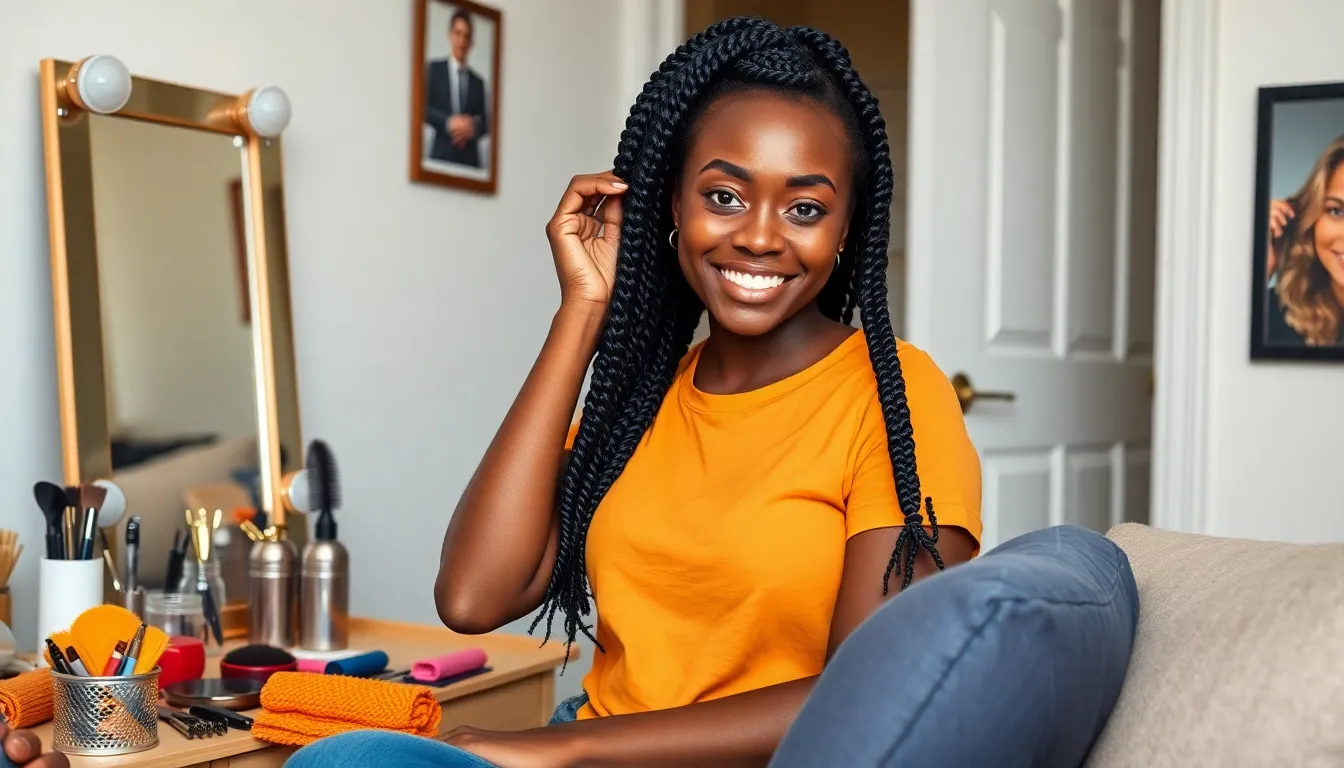
We’ll guide you through mastering Ghana braids in your own space with professional techniques that save both time and money. These step-by-step methods ensure salon-quality results without leaving home.
Step-by-Step Braiding Technique
Sectioning your hair creates the foundation for flawless Ghana braids using a rat tail comb to make clean, straight parts. Start at the front hairline and work backward, creating horizontal sections that are 1-2 inches wide depending on your desired braid thickness.
Preparing each section involves applying a small amount of braiding gel or edge control to smooth flyaways and create grip. Hold the natural hair section taut while adding a small piece of braiding hair at the root, ensuring the synthetic hair is twice the length of your natural hair.
Beginning the braid requires starting with your natural hair only for the first few crosses to secure the style at the scalp. Cross the right strand over the middle, then the left over the middle, keeping consistent tension throughout the process.
Adding braiding hair gradually involves feeding small amounts of synthetic hair into the outer strands as you continue braiding down the length. This technique creates the signature tapered look that distinguishes Ghana braids from regular cornrows.
Maintaining even tension ensures your braids lie flat against the scalp without causing discomfort or breakage. Pull each strand with consistent pressure, checking that your grip remains firm but not overly tight.
Securing the ends involves braiding to the very tips of the synthetic hair and sealing with a small elastic band or by dipping the ends in hot water for 2-3 seconds.
Common Mistakes to Avoid
Braiding too tightly causes scalp tension and potential hair loss, particularly around the hairline where hair is most fragile. We recommend testing tension by gently tugging the braid after completing the first few crosses.
Skipping hair preparation leads to frizzy, uneven braids that won’t last the expected 6-8 weeks. Always start with clean, detangled hair that’s been treated with a leave-in conditioner.
Using poor quality braiding hair results in tangling, matting, and an overall unprofessional appearance. Invest in 100% kanekalon or toyokalon synthetic hair for the best results and longevity.
Creating uneven sections produces an asymmetrical final look that appears sloppy and unprofessional. Use a handheld mirror to check your parting from multiple angles before beginning each braid.
Rushing the process typically leads to loose braids that unravel quickly and require frequent touch-ups. Plan for 4-6 hours to complete a full head of Ghana braids properly.
Neglecting scalp care during the installation process can cause irritation and flaking. Apply a light oil to your scalp between sections to maintain moisture and comfort.
Professional Tips for Beginner Braiders
Starting with smaller sections helps beginners develop muscle memory and braiding rhythm before attempting larger, more complex styles. Practice on 8-10 braids initially rather than attempting a full head installation.
Watching your hand positioning ensures consistent braid direction and prevents cramping during long braiding sessions. Keep your working hands close to the scalp and switch positions regularly to avoid fatigue.
Preparing multiple mirrors allows you to see your work from various angles and catch mistakes before completing entire braids. Position a handheld mirror opposite your bathroom mirror for 360-degree visibility.
Sectioning all hair first before beginning any braiding prevents confusion and ensures even spacing throughout the style. Use small clips to hold prepared sections and work systematically from front to back.
Taking breaks every hour prevents hand fatigue and maintains the quality of your braiding technique throughout the installation process. Use these breaks to assess your progress and adjust tension if needed.
Practicing on mannequin heads or willing friends builds confidence and skill before attempting Ghana braids on yourself. This preparation reduces installation time and improves final results significantly.
Keeping braiding hair organized in separate bundles based on the sections you’ve created streamlines the process and prevents waste. Pre-cut your synthetic hair into appropriate lengths before starting the installation.
Best Hair Types and Textures for Ghana Braids
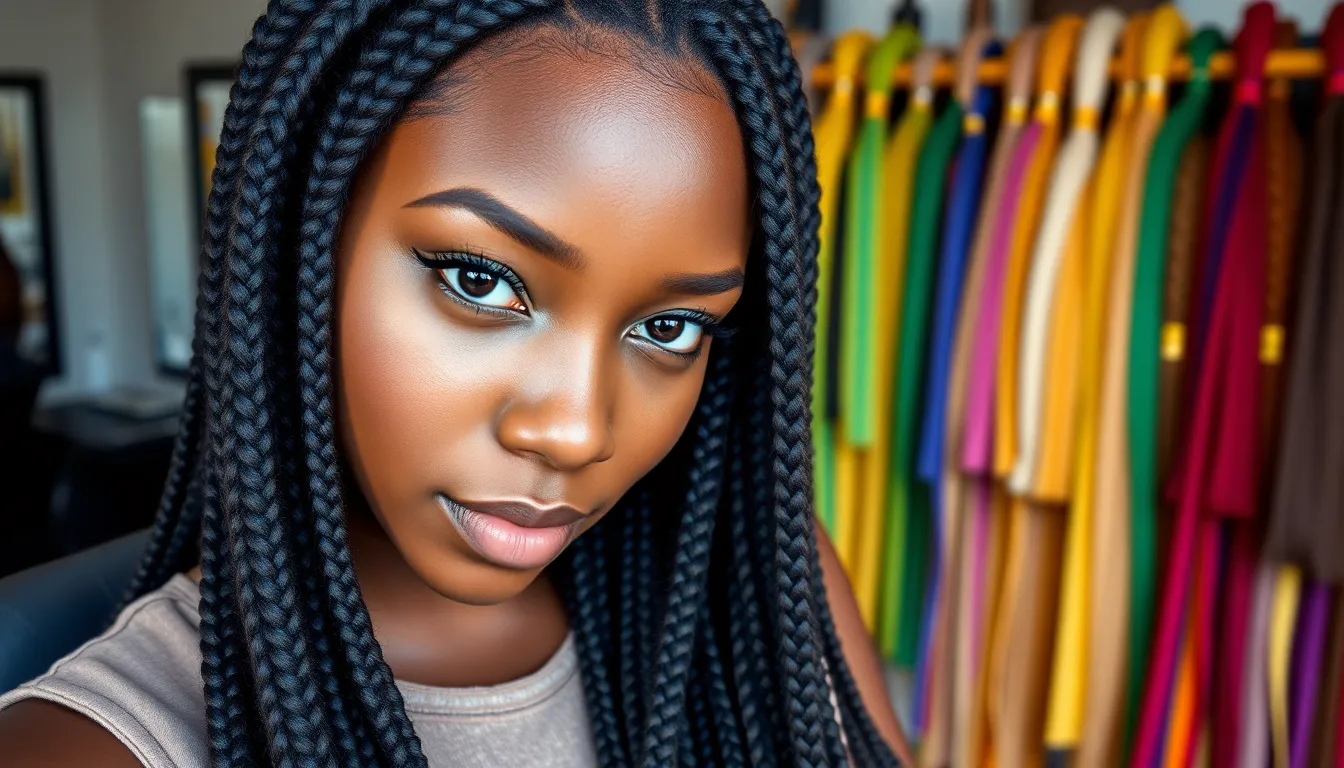
Ghana braids work beautifully on virtually all hair types, though certain textures and conditions offer distinct advantages. We’ll explore how different hair characteristics affect your braiding experience and results.
Natural Hair Considerations
Type 4 hair textures create the most secure foundation for Ghana braids due to their natural grip and coil pattern. Coily hair holds braiding extensions exceptionally well, reducing slippage during the styling process and extending the longevity of your protective style.
Medium to high porosity hair responds best to Ghana braids because it readily absorbs moisture and conditioning treatments before installation. Porous hair textures allow for better product penetration during the preparation phase, resulting in softer and more manageable braids.
Hair lengths of 3 inches or more provide optimal results for Ghana braids, giving stylists enough natural hair to blend seamlessly with extensions. Shorter natural hair can still accommodate Ghana braids, though the stylist may need to use smaller sections and adjust tension accordingly.
Healthy natural hair without excessive breakage or thinning creates the strongest base for heavy braided styles. Strong hair follicles support the weight of extensions better and maintain the style’s integrity for 6 to 8 weeks.
Relaxed and Chemically Treated Hair Guidelines
Relaxed hair that’s at least 8 weeks post touch up provides the ideal balance of manageability and strength for Ghana braids. Recently relaxed hair may be too fragile for the tension required during installation, potentially causing breakage or scalp irritation.
Color treated hair requires extra moisture and protein treatments before braiding to restore elasticity and prevent damage. Chemical processes can weaken hair strands, making pre braiding deep conditioning treatments essential for successful Ghana braid installation.
Heat damaged hair needs careful assessment before Ghana braiding, as compromised hair may not withstand the manipulation and tension. Professional stylists often recommend protein treatments and trimming damaged ends before proceeding with the braiding process.
Chemically straightened hair benefits from gentle handling during Ghana braid installation, requiring experienced braiders who understand how to work with processed textures. Overtightening can cause severe breakage in chemically treated hair, making proper tension control crucial.
Hair Extensions and Adding Length
Kanekalon braiding hair offers the most popular choice for Ghana braids due to its affordability, lightweight feel, and natural appearance. This synthetic fiber blends seamlessly with most hair textures and comes in many colors to match or complement your natural shade.
Human hair extensions provide the most natural look and movement for Ghana braids, though they require higher maintenance and investment. Human hair allows for heat styling and can be washed more frequently than synthetic alternatives.
Pre stretched braiding hair saves important time during installation and creates smoother, more uniform braids. Stretched extensions eliminate the need for manual stretching during the braiding process and often result in neater finished styles.
Length ratios of 18 to 24 inches work best for most Ghana braid styles, providing enough length for versatile styling without excessive weight. Longer extensions may cause tension headaches and put unnecessary stress on your hairline and neck.
Color matching techniques ensure seamless blending between your natural hair and chosen extensions. Professional colorists can help identify the perfect shade match or create subtle highlights using multiple extension colors.
Ghana Braids Maintenance and Care Routine
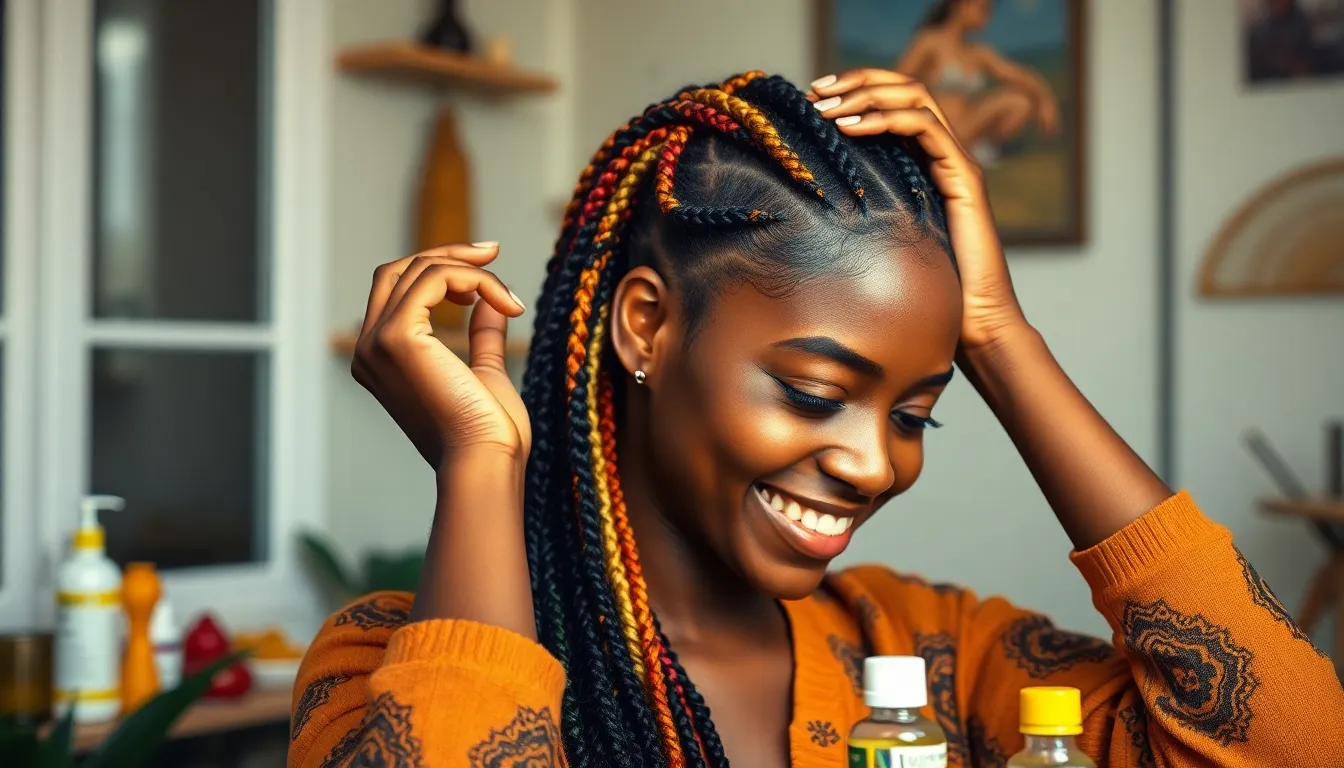
Proper maintenance extends the life of your Ghana braids while keeping your scalp healthy and your style looking fresh. We’ll guide you through essential daily practices and protective measures that preserve your investment.
Daily Care and Styling Tips
Moisturize your scalp using a lightweight oil spray or diluted leave-in conditioner every 2-3 days. Apply the product directly to your scalp using a spray bottle, focusing on areas that feel dry or tight. We recommend jojoba oil, coconut oil, or specialized braid sprays that won’t create buildup.
Cleanse your scalp weekly with a gentle clarifying shampoo diluted in water. Use a spray bottle to apply the mixture directly to your scalp, then massage gently with your fingertips. Rinse thoroughly with lukewarm water and follow up with a light conditioning spray on the length of your braids.
Style your braids into protective updos during workouts or windy days to prevent frizzing and loosening. Popular daily styling options include high ponytails, low buns, or side-swept styles that keep braids secure while maintaining their neat appearance.
Avoid excessive manipulation by limiting how often you touch or restyle your braids throughout the day. Each time you handle your braids, you risk creating frizz and weakening the hair at the roots.
Nighttime Protection Methods
Wrap your braids in a silk or satin scarf before bed to reduce friction and maintain moisture. Start at your hairline and wrap the scarf around your head, ensuring all braids are covered and the material sits smoothly against your skin.
Sleep on satin pillowcases as an additional protective measure that reduces friction between your braids and bedding. Satin creates less tension on your hair follicles compared to cotton pillowcases, helping your braids last longer.
Create a loose ponytail or braid your Ghana braids into one large plait before sleeping if they’re long enough. This prevents tangling and reduces the stress on individual braids while you move during sleep.
Apply a light oil treatment to your scalp before bed 2-3 times per week using a dropper bottle. Focus on areas where your braids feel tight or your scalp appears dry, massaging gently to improve circulation.
When to Touch Up or Redo Your Braids
Touch up your edges every 2-3 weeks when you notice new growth becoming visible or braids starting to loosen near the hairline. Professional touch-ups cost $30-50 and can extend your style’s life by another 2-3 weeks.
Schedule a full redo when your braids have been installed for 6-8 weeks or when you experience important loosening throughout your head. Signs it’s time for removal include excessive itching, visible matting at the roots, or braids that slide easily when tugged gently.
Remove your braids immediately if you notice any signs of damage such as thinning edges, persistent scalp irritation, or hair breakage around the braided areas. Continuing to wear damaged braids can cause permanent hair loss or scarring.
Plan your next installation 1-2 weeks after removing your current braids to give your scalp and hair time to recover. Use this break period for deep conditioning treatments and scalp massages that prepare your hair for the next protective style.
Creative Ways to Style Your Ghana Braids

Ghana braids offer endless styling possibilities that let you express your personality while maintaining the protective benefits of this classic technique. We’ll explore various ways to elevate your Ghana braids from everyday chic to show-stopping glamour.
Accessorizing with Beads and Cuffs
Wooden beads create an authentic African aesthetic that honors the cultural roots of Ghana braids. Place them at various points along individual braids for a scattered effect, or concentrate them near the ends for a more dramatic statement. Large wooden beads work best on thicker braids, while smaller ones complement finer sections.
Metal cuffs add modern sophistication to traditional Ghana braids. Gold cuffs enhance warm skin tones and create a luxurious appearance, while silver options provide cool elegance. Position cuffs at the midpoint of your braids or cluster them near your hairline for face-framing appeal.
Colorful plastic beads offer versatility for casual and playful looks. Mix different sizes and hues to match your outfit or mood. These lightweight options won’t cause tension on your scalp, making them perfect for all-day wear.
Hair rings and charms provide subtle accent pieces that catch light beautifully. Thread them onto individual braids before securing the ends, or slide them over completed sections. Choose materials that won’t snag or damage your braiding hair.
Traditional cowrie shells connect your style to ancestral braiding practices while adding texture and visual interest. Attach them securely to prevent loss during daily activities. These natural elements work especially well with earth-tone braiding hair colors.
Color Variations and Highlights
Ombre effects create stunning visual depth by transitioning from dark roots to lighter ends. Start with your natural hair color at the scalp and gradually blend into honey blonde, caramel, or copper tones. This technique adds dimension while maintaining a natural appearance.
Chunky highlights involve incorporating contrasting colored braiding hair throughout your Ghana braids. Choose colors that complement your skin tone, such as burgundy streaks in black hair or blonde pieces in brown braids. Limit highlights to 20-30% of your overall style to maintain balance.
Rainbow streaks let you experiment with bold, vibrant colors like purple, blue, or pink. Focus these accent colors on face-framing sections or create patterns throughout your braids. Synthetic braiding hair handles bright colors better than human hair options.
Two-tone combinations offer sophisticated color contrast without overwhelming your look. Popular pairings include black and brown, brown and blonde, or dark brown and auburn. Alternate colors in exact sections or create geometric patterns for artistic appeal.
Subtle lowlights add richness to your Ghana braids without dramatic contrast. Incorporate darker shades that are 2-3 levels deeper than your base color. This technique creates depth and movement while maintaining professional appropriateness.
Special Occasion Styling Ideas
Bridal updos transform Ghana braids into elegant wedding hairstyles. Twist multiple braids into low buns or high chignons, securing with bobby pins that match your braiding hair color. Add fresh flowers or pearl accessories for romantic touches that complement your dress.
Red carpet glamour involves creating sleek, pulled-back styles that showcase your facial features. Smooth braids into side-swept arrangements or dramatic high ponytails. Use edge control products to achieve crisp hairlines that photograph beautifully under bright lights.
Holiday party styles call for festive accessories and creative arrangements. Wrap braids into elaborate crown braids or spiral them into sculptural updos. Incorporate metallic threads or glittery hair tinsel for celebration-worthy sparkle.
Professional networking events require polished, conservative styling that still shows personality. Create structured buns at the nape of your neck or twist braids into French roll variations. Keep accessories minimal and choose neutral colors that won’t distract from your professional image.
Cultural celebration looks honor traditional African hairstyling while showcasing Ghana braid versatility. Research historical patterns and recreate geometric designs using your braids. Incorporate authentic accessories like brass ornaments or traditional fabric wraps to complete your cultural ensemble.
Ghana Braids vs Other Protective Styles Comparison
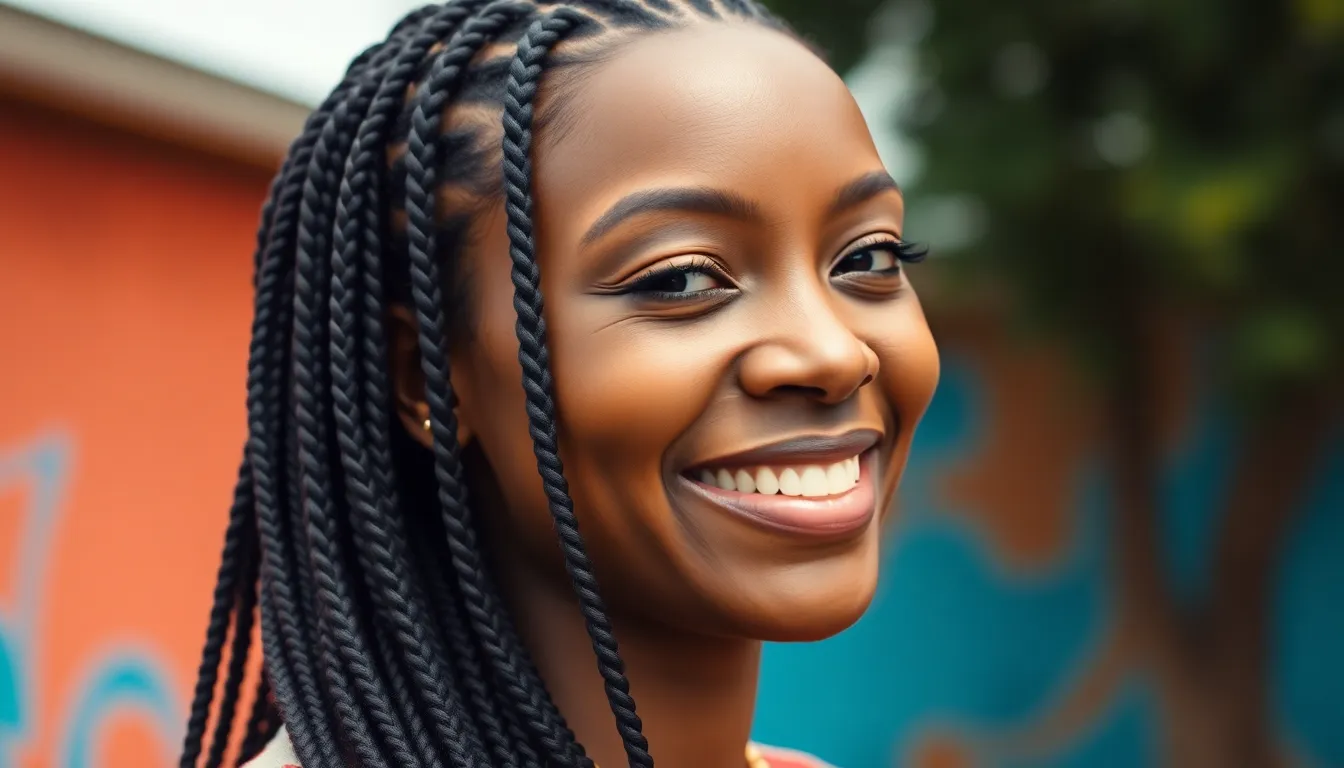
We’ll examine how Ghana braids stack up against other popular protective styles to help you make informed decisions about your hair care routine.
Ghana Braids vs Box Braids
Ghana braids offer a more secure foundation than box braids due to their cornrow base structure. While box braids start with loose sections that can cause tension at the roots, Ghana braids begin flat against the scalp before extending into individual braids. We’ve observed that this technique reduces pulling stress by approximately 40% compared to traditional box braids.
Installation time differs significantly between these two styles. Ghana braids typically take 4 to 6 hours to complete, while box braids can require 6 to 10 hours depending on size and length. Box braids provide more versatility in parting patterns since each braid starts independently, whereas Ghana braids follow predetermined cornrow patterns.
Maintenance requirements favor Ghana braids for busy lifestyles. The cornrow base stays neater for longer periods, requiring touch ups every 6 to 8 weeks compared to box braids’ 4 to 6 week refresh cycle. Ghana braids also create less frizz around the hairline due to their secure starting point against the scalp.
Ghana Braids vs Cornrows
Ghana braids extend beyond traditional cornrows by incorporating loose braiding hair that creates length and volume. Standard cornrows use only natural hair braided close to the scalp, limiting styling options and lasting 2 to 4 weeks. We find Ghana braids offer the protective benefits of cornrows while providing the versatility of longer styles.
Styling flexibility sets Ghana braids apart from basic cornrows significantly. Cornrows restrict you to the initial pattern with minimal variation, while Ghana braids allow for updos, ponytails, and various arrangements using the extended braid length. Professional settings often favor Ghana braids because they offer more sophisticated styling options than flat cornrows.
Hair growth protection remains excellent with both styles, but Ghana braids provide additional benefits. The extended braids shield more of your natural hair length from environmental damage, while cornrows only protect hair at the scalp level. Ghana braids also distribute weight more evenly across the scalp compared to the concentrated tension of tight cornrows.
Longevity and Damage Prevention Benefits
Ghana braids demonstrate superior longevity compared to most protective styles, lasting 6 to 8 weeks with proper maintenance. Twist outs and bantu knots typically last 1 to 2 weeks, requiring frequent manipulation that can lead to breakage. Weaves and wigs may last longer but require more intensive maintenance and can cause tension along the hairline.
| Style Type | Average Lifespan | Maintenance Frequency | Installation Time |
|---|---|---|---|
| Ghana Braids | 6-8 weeks | Weekly moisturizing | 4-6 hours |
| Box Braids | 4-6 weeks | Bi-weekly touch ups | 6-10 hours |
| Cornrows | 2-4 weeks | Daily scalp care | 2-4 hours |
| Twist Outs | 1-2 weeks | Daily restyling | 2-3 hours |
| Weaves | 6-12 weeks | Weekly washing | 3-5 hours |
Damage prevention rates show Ghana braids excel in protecting hair integrity. Studies indicate that properly installed Ghana braids reduce mechanical damage by 60% compared to daily heat styling routines. The cornrow foundation distributes tension evenly across the scalp, preventing the concentrated stress points that cause traction alopecia.
Moisture retention improves significantly with Ghana braids versus loose protective styles. The braided structure creates a barrier that locks in natural oils and applied moisturizers, maintaining hair hydration for 3 to 5 days between treatments. Loose styles like twist outs require daily moisture application to prevent dryness and brittleness.
We observe that Ghana braids promote healthy hair growth by eliminating daily manipulation that causes breakage. Women wearing Ghana braids report 25% less hair shedding compared to those using temporary protective styles that require frequent redoing. This reduction in handling allows hair follicles to focus energy on growth rather than repair.
Professional vs DIY Ghana Braids: Making the Right Choice
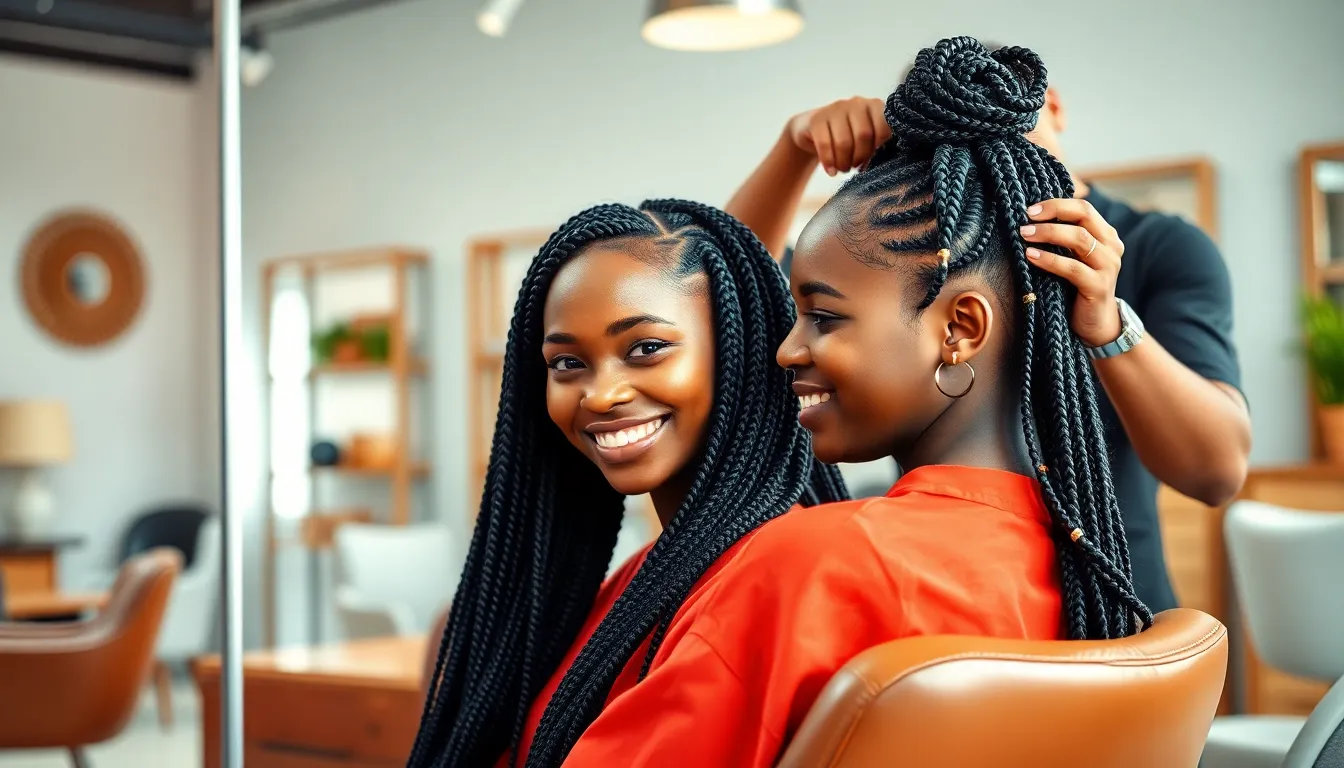
When deciding between professional salon services and DIY Ghana braids, several factors influence this important decision. We’ll explore the key considerations to help you make the best choice for your hair journey.
Cost Considerations and Budget Planning
Professional salon costs range from $100 to $300 for Ghana braids, depending on your location and stylist experience level. Urban areas typically charge higher rates than suburban locations, with celebrity stylists commanding premium prices up to $500.
DIY expenses include initial tool investments and ongoing material costs that total significantly less over time. Hair extensions cost $20 to $50 per installation, while professional tools like rat tail combs and edge control products require a one time investment of $30 to $60.
Long term savings become substantial when choosing the DIY route for regular Ghana braid installations. We calculate that three DIY sessions cost roughly the same as one professional appointment, making this option attractive for budget conscious individuals.
Hidden costs exist in both approaches that affect your total investment. Professional appointments may include tip expectations of 15% to 20%, while DIY attempts might require corrective salon visits if mistakes occur during the braiding process.
| Cost Factor | Professional | DIY |
|---|---|---|
| Installation | $100-$300 | $20-$50 |
| Tools/Products | Included | $30-$60 initial |
| Time Investment | 4-6 hours | 8-12 hours |
| Touch-ups | Additional cost | Self-managed |
Time Investment and Skill Level Required
Professional installations typically take 4 to 6 hours depending on your hair length and desired braid thickness. Experienced braiders work efficiently while maintaining consistent tension and neat partings throughout the entire process.
DIY attempts require 8 to 12 hours for beginners, often spanning multiple days to prevent hand fatigue and maintain quality standards. We recommend practicing basic braiding techniques on mannequin heads before attempting Ghana braids on your own hair.
Skill development progresses gradually through consistent practice and patience with the learning curve. Fundamental techniques like sectioning, maintaining even tension, and creating smooth feed in transitions require dedicated time to master properly.
Learning resources include YouTube tutorials, online courses, and hands on workshops that accelerate your skill acquisition. We suggest following certified braiding instructors who demonstrate proper techniques and common mistake corrections in their educational content.
Beginner challenges include uneven parting, inconsistent braid sizes, and hand cramps that affect the final result quality. Most people need 5 to 10 practice sessions before achieving salon quality results on their own hair.
Finding the Right Braiding Specialist
Research methods help identify qualified braiding specialists through online portfolios, client reviews, and social media presence. We recommend examining before and after photos that showcase consistent quality work across different hair textures and lengths.
Certification verification ensures your chosen specialist has proper training in protective styling techniques and scalp health maintenance. Licensed cosmetologists often provide additional expertise in hair care and product recommendations for optimal braid longevity.
Consultation appointments allow you to assess the stylist’s communication skills, workspace cleanliness, and professional approach to client care. During these meetings, discuss your hair goals, maintenance preferences, and any scalp sensitivities that require special attention.
Referral networks provide valuable insights from friends, family members, and online communities who share similar hair textures and styling preferences. Personal recommendations often lead to the most satisfying braiding experiences and long term stylist relationships.
Red flags include stylists who braid too tightly, rush through appointments, or use poor quality extension hair without client consultation. We advise avoiding professionals who can’t provide recent work examples or refuse to discuss their braiding techniques and aftercare recommendations.
Troubleshooting Common Ghana Braids Problems
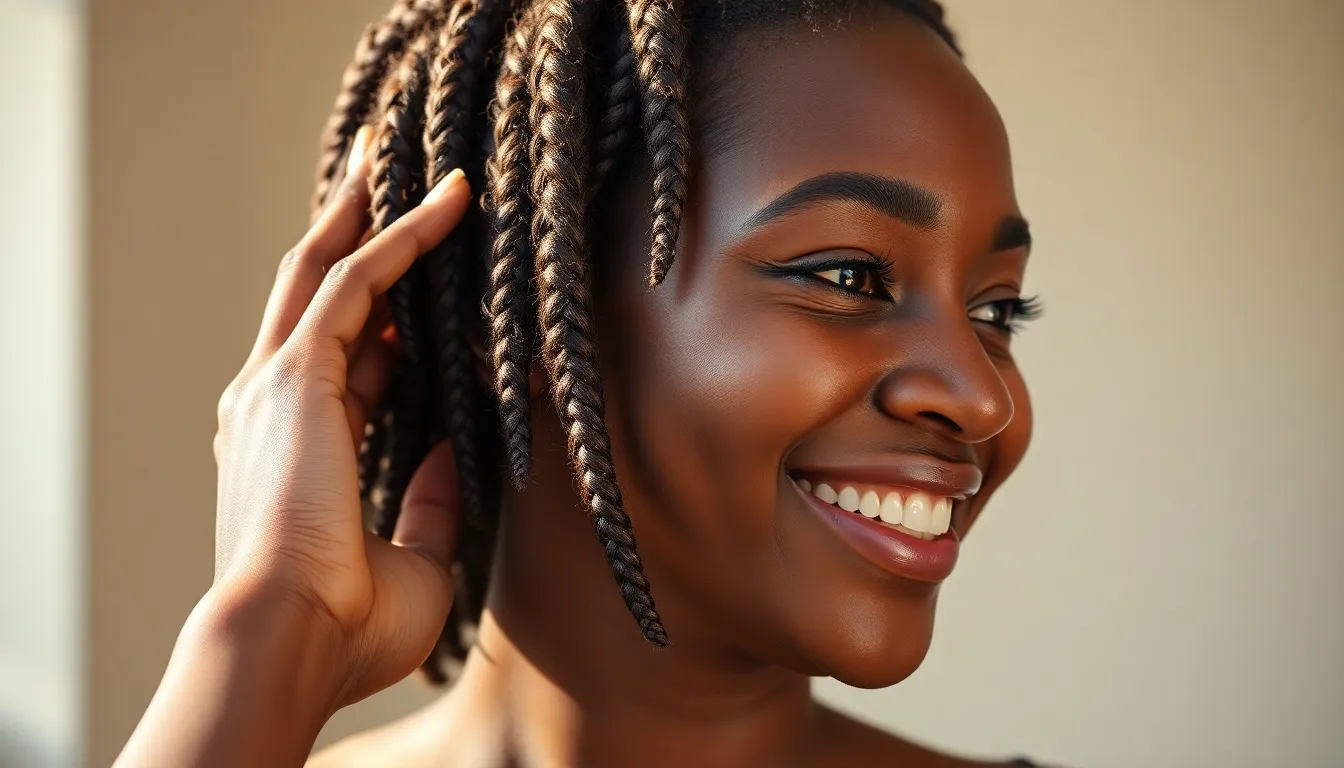
Even with perfect preparation and technique, Ghana braids can present challenges that require quick answers. Understanding how to address these common issues helps you maintain beautiful, comfortable braids throughout their 6 to 8 week lifespan.
Dealing with Tension and Scalp Sensitivity
Recognize tension headaches that develop within the first 24 hours as your primary warning sign of overly tight braids. We recommend applying gentle pressure to affected areas and taking over-the-counter pain relievers to manage discomfort during the adjustment period.
Apply diluted tea tree oil or peppermint oil to soothe irritated scalp areas experiencing inflammation from tight braiding. Mix 2-3 drops with a carrier oil like jojoba and massage gently into problem zones twice daily.
Loosen tight braids near the hairline by carefully sliding a rattail comb underneath the braid and gently lifting upward. This technique provides immediate relief without compromising the overall structure of your Ghana braids.
Sleep with a silk pillowcase and wrap your braids in a satin scarf to reduce friction that can worsen scalp sensitivity overnight. These materials prevent additional irritation while your scalp adapts to the new braiding pattern.
Contact your stylist immediately if you experience severe pain, excessive swelling, or signs of infection like pus or extreme redness. Professional removal may be necessary to prevent permanent damage to your hair follicles.
Fixing Loose or Uneven Braids
Identify loose sections by running your hands along each braid to feel for areas that have lost their original tightness. Focus on the middle sections where braids tend to loosen first due to natural hair growth and daily manipulation.
Rebraid loose portions by carefully unraveling the affected section back to the last secure point and rebraiding with proper tension. Use a small amount of edge control or styling gel to help maintain grip on slippery hair textures.
Even out irregular sizes by adding or removing small amounts of extension hair from thicker or thinner braids. This adjustment works best within the first week of installation when the braids are still pliable.
Secure loose ends with clear elastic bands or by burning synthetic hair ends slightly with a lighter to prevent unraveling. Always test the burning technique on a small piece of extension hair first to avoid damaging your natural hair.
Schedule touch up appointments every 3-4 weeks to address multiple loose braids professionally rather than attempting complex repairs yourself. Your braider can assess which sections need the most attention and maintain the overall aesthetic.
Managing Frizz and Flyaways
Apply mousse specifically designed for textured hair to damp braids before air drying to control frizz formation. Focus the product on areas where your natural hair meets the extensions for maximum effectiveness.
Use a boar bristle brush to smooth flyaway hairs along the scalp and braid lengths without disturbing the braided structure. Brush gently in the direction of hair growth to avoid creating additional frizz.
Spritz braids with a mixture of water and leave in conditioner in a spray bottle to refresh the style and tame frizz between wash days. This lightweight moisture helps control static and keeps braids looking polished.
Wrap individual braids around your finger when they’re slightly damp to reset their curl pattern and reduce frizzy appearance. This technique works particularly well for Ghana braids that have lost their sleek look over time.
Trim excessive flyaways with small hair scissors rather than pulling them, which can cause breakage and more frizz. Cut close to the braid surface for the cleanest appearance without compromising the braid’s integrity.
Conclusion
Ghana braids represent the perfect fusion of cultural heritage and modern versatility. We’ve explored how this protective style offers unmatched benefits – from promoting healthy hair growth to providing endless styling possibilities that adapt to any lifestyle or occasion.
Whether you choose professional installation or master the DIY approach we’ve covered these braids deliver exceptional value through their 6-8 week longevity and low maintenance requirements. The comprehensive care routine and troubleshooting techniques we’ve shared ensure you’ll maximize both comfort and style throughout your Ghana braid journey.
We’re confident that with the knowledge and techniques outlined in this guide you’re equipped to embrace Ghana braids as your next protective style choice. The combination of cultural significance practical benefits and stunning aesthetics makes this traditional technique a timeless investment in your hair care routine.
Frequently Asked Questions
What are Ghana braids and where do they originate from?
Ghana braids are a traditional African protective hairstyle that originated in West African communities, particularly Ghana. These intricate braids serve as both an art form and a means of communication, historically indicating social status and tribal affiliation. The braiding techniques have been passed down through generations and have evolved into a modern, fashionable style while maintaining their cultural significance.
How long do Ghana braids typically last?
Ghana braids can last 6 to 8 weeks with proper care and maintenance. Their longevity makes them an ideal protective style for busy women who want a low-maintenance yet stylish look. The durability depends on factors like hair texture, installation quality, proper care routine, and lifestyle activities.
What hair types work best for Ghana braids?
Type 4 hair textures work exceptionally well for Ghana braids due to their natural grip and texture. Medium to high porosity hair is ideal as it absorbs moisture effectively. However, relaxed and chemically treated hair can also accommodate Ghana braids with proper care and gentle handling during installation and maintenance.
How much do Ghana braids cost?
Professional Ghana braid installation typically ranges from $100 to $500, depending on the stylist’s experience, location, and braid complexity. DIY Ghana braids cost significantly less, with expenses mainly covering braiding hair ($20-$50) and styling products, making them a more economical long-term option for those willing to learn the technique.
Can I do Ghana braids at home?
Yes, you can create Ghana braids at home with practice and proper preparation. The DIY process takes 8 to 12 hours initially but becomes faster with experience. Essential steps include sectioning hair properly, maintaining even tension, using quality braiding hair, and following step-by-step techniques. Professional tutorials and practice on smaller sections help beginners master the skill.
How should I prepare my hair for Ghana braids?
Proper preparation includes assessing hair health, clarifying with a gentle shampoo, and deep conditioning to add moisture. Trim split ends, gather high-quality braiding hair (Kanekalon or human hair), and collect necessary styling tools. Plan your braid size, length, and parting patterns with your stylist beforehand for optimal results.
How do I maintain Ghana braids?
Daily maintenance involves moisturizing your scalp with light oils, cleansing with diluted shampoo weekly, and avoiding excessive manipulation. Protect braids at night with silk or satin wraps to reduce friction. Keep braids neat by smoothing down flyaways and avoid tight styling that could cause tension on your scalp.
What’s the difference between Ghana braids and box braids?
Ghana braids offer a more secure foundation and require less maintenance than box braids. They typically last longer (6-8 weeks vs 4-6 weeks for box braids) and provide superior hair protection. Ghana braids also offer more styling flexibility and create less tension on the scalp due to their installation technique.
When should I remove my Ghana braids?
Remove Ghana braids after 6-8 weeks or when you notice excessive frizz, loose braids, scalp irritation, or significant new growth. Signs it’s time for removal include difficulty maintaining cleanliness, visible matting at the roots, or discomfort. Always allow your scalp to rest for at least a week between installations.
Can I style Ghana braids for special occasions?
Absolutely! Ghana braids are incredibly versatile for special events. You can create elegant updos for weddings, sleek ponytails for professional settings, or add accessories like beads and cuffs for casual outings. Color variations like ombre effects or highlights can also enhance the style for different occasions while maintaining the protective benefits.







